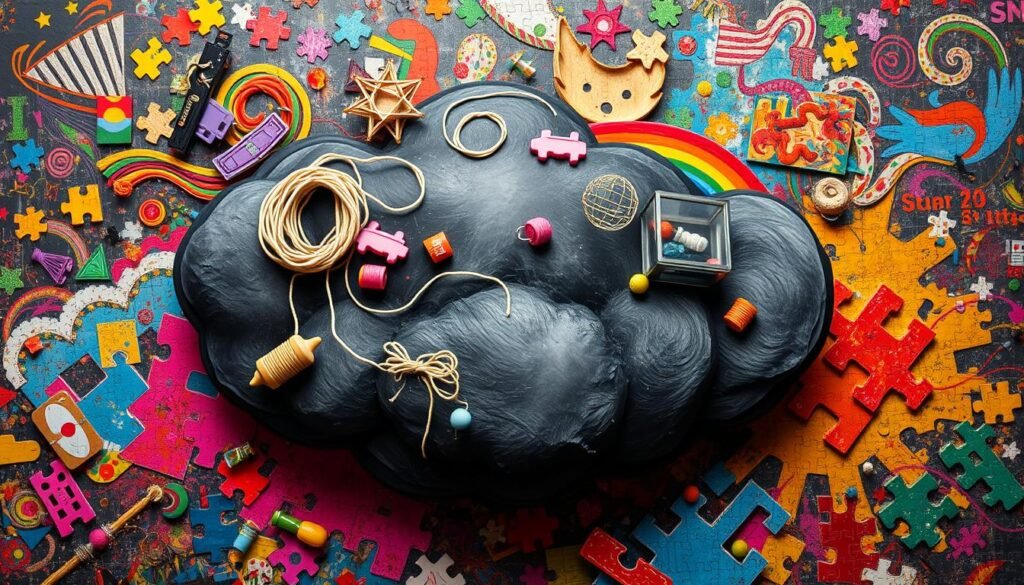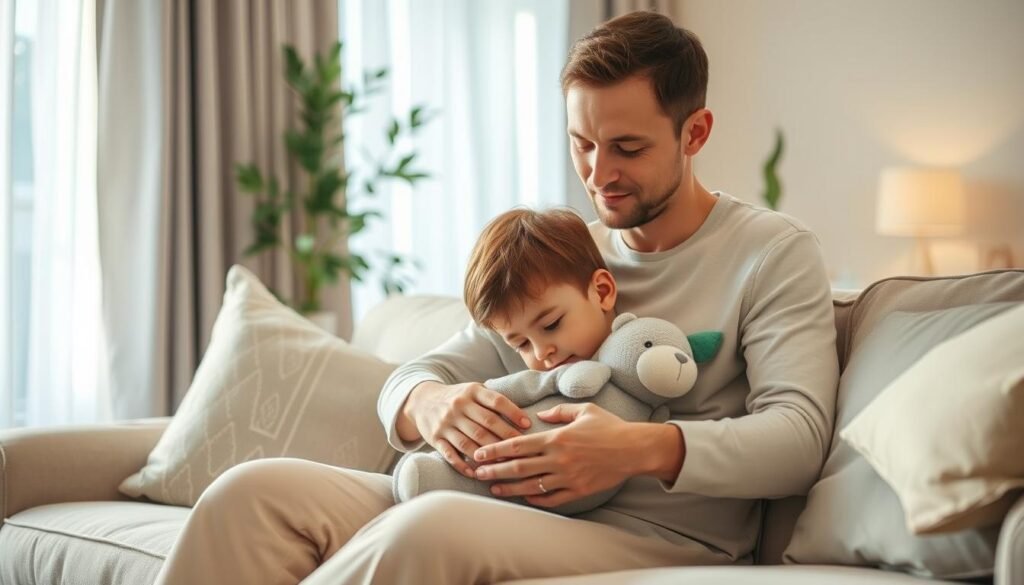About 32% of young people in the U.S. have an anxiety disorder. This makes anxiety one of the top mental health issues for kids. Parents need to know how to support a child with anxiety. This guide gives insights into different anxiety disorders in children. It also provides strategies for kids to cope with anxiety, helping them to be resilient.
Kids face many stressors, from school to changes at home. Having the right strategies helps parents support their kids well. By showing empathy and talking openly, parents can have a big impact. They can help their child deal with tough emotions. This guide covers important aspects of childhood anxiety. It gives parents the tools they need to help their anxious child.
Key Takeaways
- 32% of adolescents in the U.S. face anxiety disorders, highlighting the need for effective support strategies.
- Understanding anxiety symptoms can help in recognizing when a child may need assistance.
- Encouraging healthy coping mechanisms can enhance a child’s ability to manage anxiety.
- Establishing routines provides children with a sense of safety and security.
- Open communication about feelings can foster emotional resilience in children.
- Engaging in physical activities and creative outlets can significantly reduce anxiety levels.
- In severe cases, seeking professional support may become necessary for effective management.
Understanding Childhood Anxiety Disorders
Childhood anxiety disorders involve excessive worry that affects a child’s day-to-day life. They take various forms, like Generalized Anxiety Disorder and Social Anxiety Disorder. It’s key to note that about 32% of U.S. teens face these issues, starting as early as four to eight years old.
Anxiety in kids can come from both their surroundings and their genes. For example, separation anxiety is common in tots about six months to three years old. It usually goes away by age three. Young kids might also be afraid of bugs or the dark, but these fears often fade as they grow.
When anxiety in kids becomes severe, it shows through signs. They might get irritable, have trouble sleeping, or feel sick often, making school hard. Teens, in particular, might develop social anxiety. This makes them steer clear of hanging out with others.
Bad experiences, like accidents or family troubles, can make anxiety worse in kids. Anxiety can show up in many ways and really impact their life. Getting professional advice is crucial when anxiety gets too heavy. Treatments like Cognitive-Behavioral Therapy work well. It helps kids change how they think. Parents and caregivers are crucial too. They help their kids face their fears slowly, which can improve things a lot.
For more info and resources on this topic, check out this useful guide on childhood anxiety.
Identifying Child Anxiety Symptoms
It’s essential for parents to spot signs of anxiety in their kids early. Often, kids won’t tell us how they’re feeling. So, we need to keep an eye out for changes in how they act. Depending on their age, what anxiety looks like can differ.
Younger children might get irritable, can’t sit still, or have big reactions to small problems. They also might say they have a headache or stomachache when they’re actually worried.
As kids become teenagers, anxiety changes too. Their emotions might seem all over the place. This can come from worries about how they look, doing well in school, or fitting in with friends. Teens might pull back from hanging out, have bad dreams often, or find it hard to focus.
It’s key to know about these different signs. If we don’t help them, anxiety can cause bigger issues later on. Research tells us that quite a few kids will face anxiety disorders before they’re 18. What’s more, many don’t get the help they need. Talking openly with your kids can help you spot these signs sooner.
| Age Group | Common Symptoms | Potential Triggers |
|---|---|---|
| 6 months – 5 years | Irritability, tantrums, complaints of physical ailments | Separation from caregivers, changes in routine |
| 6 years – 12 years | Social avoidance, excessive reassurance-seeking, headaches | School pressures, family dynamics, traumatic events |
| 13 years – 18 years | Withdrawal, nightmares, concentration issues | Peer relationships, academic stress, self-image concerns |
Understanding child anxiety deeply helps parents tackle it better. Early recognition is key. This proactive stance on mental health could lessen the risk of issues later. Like not knowing how to deal with stress or turning to unhealthy ways to cope in their teen years.
How to Help a Child with Anxiety
Helping a child with anxiety starts by noticing the signs. Parents need to watch their child’s actions and talk about feelings. Knowing what makes a child anxious, like stress from friends, school, and pandemic worries, is key. This helps parents know when to seek expert advice. It’s crucial for building a child’s emotional strength.
Recognizing the Signs of Anxiety
Anxiety in kids can show as behavior changes, headaches, stomach aches, and sleep trouble. They might also stop liking activities they once enjoyed. When parents know these signs, they can better help their kids. It’s important to encourage kids to talk about their feelings. Making them feel heard and safe to share worries is essential.
Distinguishing Between Normal Worries and Anxiety Disorders
Not all worries mean a child has an anxiety disorder. Normal stress from life’s events is expected in childhood. But, parents need to tell apart normal stress from anxiety that interferes with everyday life. A 2022 study showed that kids aged 7 to 10 who learned breathing exercises saw a big drop in anxiety. This shows the value of coping skills and relaxation methods. Looking at resources like effective coping strategies can help too.
Teaching kids to face rather than avoid fear is key to their emotional development. Parents can show healthy ways to cope, creating an environment where kids can face fears. This approach helps kids handle anxiety now and in the future.
Anxiety in Children: Causes and Contributing Factors
Understanding what causes anxiety in kids shows how different factors interact. This knowledge helps parents support their anxious children better.
Environmental Influences and Biological Factors
Many things in a child’s environment can start anxiety disorders. Situations like trauma, family illness, or big life changes make anxiety worse. Being around violence, bullying, or neglect also increases a child’s risk.
Genes matter too. Kids with family members who have anxiety are much more likely to experience it themselves. This shows why it’s key to notice if a child seems anxious. Some medications, like those for allergies or asthma, can make anxiety stronger.
Impact of Family Dynamics on Childhood Anxiety
The way a family acts together affects a child’s anxiety. When parents are often anxious, their kids might feel that anxiety too. This can make it likely for the kids to have anxiety disorders. Being too protective can also raise a child’s anxiety because it stops them from facing challenges alone.
Knowing about family impacts can help lessen anxiety in kids. It offers a clearer path to tackle their fears and improve their emotional health.

Effective Anxiety Coping Strategies for Kids
Helping kids handle their emotional challenges is crucial. Different techniques can provide immediate relief and build resilience. Calming techniques are key in teaching kids life-long coping skills.
Calming Techniques for Anxious Children
Various methods can soothe kids in stress. Deep breathing exercises help kids enter a calm state, reducing heart rates and muscle tension. The 5-4-3-2-1 grounding technique focuses on the senses, aiding in distraction from anxiety. Even a simple hug can offer comfort and a sense of peace.
Developing Healthy Coping Mechanisms
Building a set of healthy coping strategies is vital. A toolkit might have bubbles, feathers, or stuffed animals for comfort. Adding mindfulness, calming scripts, and visual calming cues helps lower anxiety. Transitional objects, like a favorite stuffed toy, offers comfort, especially at bedtime. Regularly using these methods brings lasting positive effects in managing emotions.
| Coping Technique | Description |
|---|---|
| Deep Breathing | Helps switch the body into relaxation mode by lowering the heart rate. |
| 5-4-3-2-1 Grounding | Focuses on the senses to distract from worries. |
| Coping Skills Toolbox | Includes items like bubbles and stuffed animals for comfort. |
| Calming Jar | A container filled with glitter paint and water to promote relaxation. |
| Progressive Muscle Relaxation | Involves squeezing and relaxing muscles to relieve tension. |
Parenting an Anxious Child: Best Practices
Parenting an anxious child can make a big difference in their happiness. By being supportive and leading by example, parents can guide their kids through tough times. Knowing how to be a role model and create a safe space at home is key to helping them deal with anxiety.
Being a Positive Role Model
Kids learn by watching us. If parents handle stress in healthy ways, like deep breathing or sharing feelings, it teaches kids to do the same. Showing them it’s okay to feel anxious and how to face those feelings can really help them.
Creating a Supportive Home Environment
It’s important to have a home where kids can talk openly about how they feel. This means:
- Letting them know it’s alright to be anxious.
- Helping them get ready for stressful events without overthinking.
- Working together to come up with ways to face their fears, which boosts their confidence.

Being a good parent can help reduce a child’s anxiety. It’s better to gently face fears instead of avoiding them. Listening carefully and asking questions helps kids think about their feelings, which makes them stronger in dealing with anxiety.
| Practice | Benefits |
|---|---|
| Modeling Calmness | Kids learn to handle anxiety by seeing how we do it. |
| Open Communication | Kids feel comfortable sharing their feelings, which makes them feel less alone. |
| Problem-Solving Skills | Helps kids become independent and better at dealing with stress. |
| Emotional Validation | Makes kids feel heard and understood, which helps them emotionally. |
To wrap it up, parenting in the right way supports a child’s emotional well-being. Being a good example and providing a loving environment teaches them how to overcome anxiety.
Managing Childhood Anxiety Through Open Communication
Open communication is key to managing childhood anxiety. It creates a safe space for children to express their thoughts and fears. By talking about their emotions, children can learn how to cope better. These conversations boost kids’ emotional smarts and make them feel understood.
Encouraging Healthy Discussions About Feelings
To help kids share, start by asking questions that make them think. Ask things like, “What made you feel worried today?” This lets kids open up about their emotions. It’s a good way to deal with anxiety and helps them understand their feelings better.
Validating Emotions Without Reinforcing Anxiety
It’s important to show kids that their feelings are okay. Parents need to support them but not make anxiety worse. They should encourage positive thinking. This teaches kids to deal with their fears without increasing their anxiety.
| Communication Strategies | Benefits |
|---|---|
| Open-ended questions | Encourages deeper expression of feelings |
| Active listening | Builds trust and understanding |
| Emotion validation | Normalizes feelings, reduces shame |
| Gentle redirection | Promotes positive coping strategies |
| Routine discussions | Establishes comfort in sharing feelings |
Child Therapy for Anxiety: When and Why to Seek Help
Child therapy helps kids deal with too much worry or fear. It’s vital for parents to notice when their child needs help. This is crucial if the child’s daily life is disrupted or if home solutions don’t work.
Types of Therapeutic Approaches
There are many ways to help kids with anxiety. Some key methods include:
- Cognitive Behavioral Therapy (CBT): Changes bad thought patterns and actions.
- Play Therapy: Lets kids share feelings safely through play.
- Mindfulness-Based Interventions: Teaches staying in the moment to control worry.
- Exposure Therapy: Slowly lets kids face fears to lessen worry.
Each therapy type has its own advantages. The key is to match the therapy with the child’s needs.
Finding the Right Professional Support
Choosing the right help means looking at different factors to find a good match for the child. Things to think about include:
| Factor | Importance |
|---|---|
| Credentials | Confirms the therapist can give proper help. |
| Experience | A therapist with experience in child anxiety can offer better help. |
| Compatibility | A strong bond between kid and therapist helps healing. |
| Location | Easy to get to therapy means the child can go regularly. |
Careful selection helps kids get on the right path to handle anxiety. Good therapy improves a child’s life greatly.

Building Resilience in Anxious Children
Building resilience in anxious kids is key for their emotional growth and future happiness. Parents are crucial in this, using supportive strategies that help children tackle challenges. By setting small, achievable goals, children feel success early on. This lets them slowly face their fears. Overcoming these small obstacles shows them that they can handle bigger stressors later.
Setting Small, Achievable Goals
Setting and hitting small goals boosts a child’s emotional toughness. Studies reveal that overcoming hurdles builds their belief in themselves. Seeing their own success, children trust in their abilities more. This method promotes dealing with problems head-on instead of avoiding them. A ratio of 5 positive interactions to every negative one also builds their confidence, supporting their resilience journey.
Encouraging Independence and Problem-Solving Skills
Helping kids be independent is crucial for resilience. Teaching them to solve problems gives them the power to face tough situations alone. Handling disagreements with friends or solving a school project are chances for growth. Developing unique hobbies helps them feel connected and boosts their resilience. These activities not only enhance their social life but also prepare them for future challenges. Learn more about building resilience in children here.
Additional Resources and Support for Parents
Parents face challenges in dealing with childhood anxiety. It’s vital they find good resources and support. Books, websites, and community groups are key for helping their kids.
Books, Websites, and Organizations
There are many books on children’s anxiety. They give parents tips and ways to help. Here are some recommended titles:
- The Anxiety Workbook for Kids
- Helping Your Anxious Child
- What to Do When You Worry Too Much
- When My Worry Gets Too Big
- Beyond the Blues
These books are for kids aged 3-12 years. They talk about various anxieties, like fears at bedtime or worries about being apart. There are also books for parents written by experts.
Also, there are helpful websites for childhood anxiety:
- Anxiety and Depression Association of America (ADAA)
- American Academy of Pediatrics
- Child Mind Institute
- National Institute of Mental Health
These are among 12 suggested sites. They provide around 83.3% of needed aid for childhood anxiety.
Community Support Groups for Parents
Community groups help parents feel part of a team. Sharing stories and advice is beneficial. It makes handling childhood anxiety feel less lonely.
So, if you’re parenting an anxious child, remember there’s lots of help out there. Use books, websites, and groups to learn and get support. They provide tools and understanding to help your child.
| Resource Type | Recommended Number | Age Range | Anxiety Disorders Covered |
|---|---|---|---|
| Books for Kids | 13 | 3-12 years | Generalized anxiety, bedtime fears, selective mutism, separation anxiety, OCD, PTSD |
| Books for Parents | 7 | N/A | General parenting and anxiety management |
| Websites | 12 | N/A | General childhood anxiety resources |
Conclusion
Helping a child with anxiety is a steady journey. It needs patience and active efforts from parents. Recognizing symptoms early, creating a safe space, and talking about feelings helps a lot. It’s vital to understand that many kids face anxiety. So, tackling it with care and persistence is key.
To manage childhood anxiety, physical activities like running are helpful. They help distract and ease stress. Using hugs to boost oxytocin can comfort anxious children. When needed, seeking professional help, like cognitive behavioral therapy, is crucial for their lasting emotional health.
The main goal is to help a child overcome anxiety by building resilience. Giving them tools to manage their emotions is critical. By using the strategies in this guide, parents can lessen anxiety’s effects. They can also help their child grow and face life’s hurdles successfully.